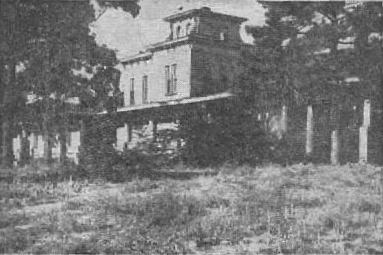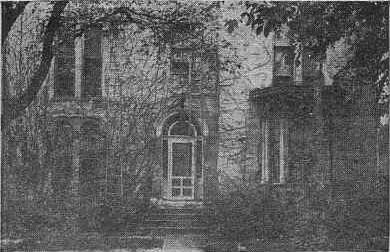
No. 3--Old Butler Mansion

No. 3--Old Butler Mansion
Lincoln was chosen as the capital of Nebraska in the summer of 1867 by three young men, David Butler, John Gillespie and Thomas Kennard, who had been named as a commission to do this task. They have become almost legendary figures in the minds of Nebraskans--three men in tall silk hats silhouetted against the prairie sky as they pounded their ponies over the countryside in search of a capital site.They were very actual people, however: Butler was the state of Nebraska's first governor; Thomas Kennard, first secretary of state and Gillespie first state auditor. Interestingly, the homes built by these three men still stand, perhaps the three oldest houses in Lincoln. Herewith is shown the onetime mansion of Governor Butler, which has stood at Seventh and Washington for almost 75 years. At that time of course there were no such streets. The mansion was a country home, from which the governor drove to the capitol and back in state.
The original house was square and high, built of blocks of brown stone with a cupola and a front stoop instead of a porch. It was considered very imposing. Here Governor Butler lived from about 1867 until his impeachment in 1871. The impeachment by the legislature came about because of Butler's borrowing $17,000 from the school fund. Land which he had deeded to the state was said to have more than paid in value the amount borrowed, and great bitterness resulted from the legislature's action.
"Lord" Jones, a rich English man, purchased the building in the early 70's. Thirty years later the Lincoln Country club took it over and added wings. The mansion has been used variously since as the home of the ku klux klan, a radio broadcasting studio and a dance house. Now, hands patiently folded, it awaits the auctioneer's hammer.

No. 4--Kennard House
Like the Butler mansion, the Kennard house at 1627 H was built in the late 60's. Exteriorly it has been little changed and indicates fairly well the style of the more pretentious houses of that period.Thomas Kennard was a colorful figure of the times. On the streets of the raw prairie city he sported a frock coat, black velvet vest and a silk hat, which was perhaps legitimate dress for a man of his importance. He had helped select Lincoln as the capital of Nebraska. Later he was railroad attorney, state senator and an appraiser of Indian lands for the federal government. In 1890 he organized the Western Glass & Paint company, still in existence. In 1898 he was appointed by President McKinley receiver of public moneys at the U. S. land office in Lincoln.
Choosing a site for the capitol was not as simple as it sounds 75 years later. Omaha clung to the honor with grim fingers. Ashland was bitter at not being chosen. The $50,000 bonds of the commissioners had been filed with the chief justice, but not with the state treasurer, as the law specified. Disgruntled Omaha people said the commissioners therefore had no legal standing and they planned to prevent the removal of the state papers, and in fact the capital, to Lincoln by having an injunction issued. Gov. Butler and Mr. Kennard formulated a plan. On Sunday morning Mr. Kennard drove to Omaha, entered the state house, took the seal of state, wrapped it up carefully and put it under the seat of his buggy. He arrived in Lincoln next morning after stopping in Ashland overnight. The governor's proclamation, ready and waiting that morning announced that the capital was now removed.
Mr. Kennard lived to celebrate his 90th birthday. He was by that time a gentle old man in quiet dress, yet about him still hovered, one felt, the aura of the empire builder.
|
|
|
|